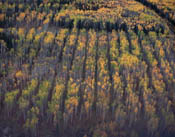EMEND Project Introduction
The EMEND project is the product of visionary leadership by: Dr. John R. Spence, University of Alberta and Dr. Jan Volney (formerly of Canadian Forest Service).
 Aerial view of EMEND Adoption of the “natural disturbance” paradigm for boreal forest management has led away from the extensive clear-cutting and toward retention of unharvested residuals to leave structure on the landscape. Effects of size and distribution of residual patches have been studied in Alberta. However, the important question of “how much residual is enough to preserve and protect critical aspects of ecosystem function?” has received scant attention. Thus, there is little scientific basis to guide management of stand structure in the extensive management zone.
Aerial view of EMEND Adoption of the “natural disturbance” paradigm for boreal forest management has led away from the extensive clear-cutting and toward retention of unharvested residuals to leave structure on the landscape. Effects of size and distribution of residual patches have been studied in Alberta. However, the important question of “how much residual is enough to preserve and protect critical aspects of ecosystem function?” has received scant attention. Thus, there is little scientific basis to guide management of stand structure in the extensive management zone.
 50% retention 50% deciduous retention at EMEND Retention of either green-tree or dead residual can be significant for forest regeneration. Therefore, sustainable forest management depends on linking harvest methods to forest regeneration procedures to promote holistic and ecologically-sensitive silviculture. New silvicultural procedures are required to meet the expanded objectives of sustainable management and to assist with evaluation of their implications for productivity.
50% retention 50% deciduous retention at EMEND Retention of either green-tree or dead residual can be significant for forest regeneration. Therefore, sustainable forest management depends on linking harvest methods to forest regeneration procedures to promote holistic and ecologically-sensitive silviculture. New silvicultural procedures are required to meet the expanded objectives of sustainable management and to assist with evaluation of their implications for productivity.
The Ecosystem Management Emulating Natural Disturbance (EMEND) Project, located near Peace River, Alberta, Canada, is a large-scale variable retention harvest experiment designed specifically to answer questions about how retention of green tree residuals affects harvest cost, forest regeneration, patterns of succession, biodiversity, nutrient cycling, ground water characteristics and public perception. EMEND is a long-term project that began in 1998 and is forecasted to run for one stand rotation, or approximately 80-100 years.
The overall objectives of the EMEND project are:
- to determine which forest harvest and regenerative practices best maintain biotic communities, spatial patterns of forest structure, functional ecosystem integrity in comparison with mixed-wood landscapes that have originated through wildfire and other inherent natural disturbances; and
- to employ economic and social analyses to evaluate these practices in terms of economic viability, sustainability and social acceptability.
These objectives are to be achieved through the large-scale harvest-silviculture experiment or approached through modelling based on the experimental results.
